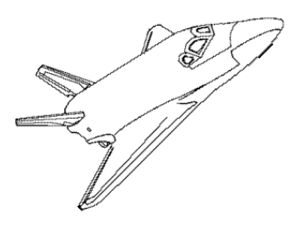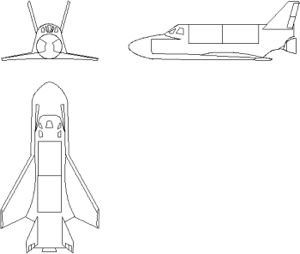
Home - Search - Browse - Alphabetic Index: 0- 1- 2- 3- 4- 5- 6- 7- 8- 9
A- B- C- D- E- F- G- H- I- J- K- L- M- N- O- P- Q- R- S- T- U- V- W- X- Y- Z
LKS

Chelomei spaceplane
AKA: Chelomei Space Interceptor. Status: Mock-up 1983. Payload: 4,500 kg (9,900 lb). Gross mass: 25,000 kg (55,000 lb). Unfuelled mass: 23,000 kg (50,000 lb). Height: 19.00 m (62.00 ft). Span: 11.00 m (36.00 ft).
Although it reached the mock-up stage, in 1983 further development of the LKS was stopped.
The LKS consisted of a reusable winged spacecraft forward of an expendable payload section. Equipment or samples to be returned to the Earth would be moved to the payload bay of the LKS itself before re-entry using a remote manipulator arm. This arrangement was similar to that proposed later for the European Hermes spaceplane. The LKS itself had a shuttle-like configuration with double-delta wings, but twin canted horizontal stabilizers. It would be launched atop a Chelomei Proton booster.
Design was begun in 1975 and a draft project was completed in 1980. Kremlin politics again ensnared Chelomei and brought the project to a halt. In 1983 further development of the LKS was stopped. A group of unidentified saboteurs (possibly KGB) broke into the premises of NPO Mashinostroyeniye in early March 1991 and destroyed the mock-up. Chelomei was even subjected to criminal investigation for having engaged in design of the spacecraft without a specific enabling government decree.
From 1965 to 1975 Chelomei was kept out of Soviet spaceplane projects. But his enthusiasm for the Raketoplan concept never died, and covertly new variants were designed with revised layouts.
When studies of spaceplanes were initiated within the industry in 1975, Chelomei proposed to co-operate on the Buran project. But he could not agree to the selected design, which duplicated the dimensions of the US space shuttle. He proposed an alternative, a light spaceplane, which could be launched from a variety of platforms. The exiting Proton booster, Ekranoplan surface-effect aircraft, conventional aircraft, and land-based acceleration carts on rail were considered as launch platforms. Design approaches included jettisonable chassis and variable geometry wings. Chelomei collaborated with a long list of national institutes and design bureaus in these trade studies.
The selected LKS design solved a wide range of national military, scientific, and national economic problems. It could deliver functional payloads to orbit, monitor their functions during all stages of flight, and then return them to earth. It also represented an economical solution to resupply of orbital space stations with crews and supplies. The LKS was designed for air launch from a range of aircraft types. It also represented a quick response solution to the Soviet leadership's fears that the shuttle was being tested for the expressed purpose of a first nuclear strike on Moscow.
After thorough analyses of potential configurations, Chelomei selected variant 2 (awarded USSR patent 188442). This had a launch mass of 25 metric tons, including 4 to 5 metric tons of payload and 2 metric tons of maneuvering propellant. Maximum use was made of actual flight test data from the MP-1 and M-2 sub-scale Raketoplan vehicles flown in the early 1960's. Major spacecraft systems were off-the-shelf items developed for the Almaz / TKS space station (e.g. engine section, guidance elements, environmental control system, thermoregulation system, heat shield, reusable equipment). Two variants were proposed: an unmanned version, with a lifetime on orbit of one year, and a manned version with two to three crew, capable of ten days of operations in space.
The refined design was a tail-less lifting body with double-delta wings. The wing angle and form were optimized for aerodynamic braking at 50 km altitude, maneuvering from 50 to 15 km altitude, and high lift to drag on the landing approach. The wing-fuselage interface was blended to endure static and dynamic forces over a wide speed range. Two-part elevons were used for stabilization and maneuver at hypersonic velocity, and were sized for various angles of attack at supersonic speeds, subsonic cruise flight, and landing maneuver. The twin vertical surfaces were effective at all flight speeds. The trapezoidal form of the rudders provided maneuverability in transonic and subsonic flight.
The LKS was equipped with a liquid rocket engine which was used for orbital maneuver, braking from orbit, and control in the initial re-entry phase. It could also increase the speed of the spaceplane on the landing maneuver in case of a missed approach or undershoot. The payload bay could accommodate all foreseen return payloads. The glider was capable of a 2000 km cross-range and had a landing speed of 300 km/hour. Tricycle landing gear consisted of a nose wheel and cantilevered skid main gear.
The heat shield was certified for 100 re-entries. A completely novel approach dispensed with the cumbersome heat shield tiles used on Buran and the shuttle.
Chelomei's program plan envisioned launch of the first LKS within four years from go-ahead from existing Proton launch pads at Baikonur. In 1980 the 25 volume technical specification for the complete LKS system was completed, a full-size mock-up was built, and a 15 volume construction plan for a fleet of LKS orbiters was prepared. This was followed by a draft project for the complete RKK Proton-LKS system. Barmin's Spetsmash design bureau assisted in the system and ground facilities design. It has been said that the mock-up was built in one month and displayed to the military leadership in an attempt to get the Buran program cancelled.
In September 1983 a State Commission reviewed Chelomei's LKS on behalf of Minister of Defense V M Shabanov. The commission was headed by A P Aleksandrov of the Academy of Sciences and members included Ye A Fedoseyev (Minister of Electronic Industries), and G V Kisunko (General Designer Antiaircraft Systems).
Chelomei proposed use of LKS as a massive counter-response to the American Strategic Defense Initiative. 360 LKS launches would take place over four years, requiring 90 Proton launches per year. Each would deploy laser platforms that would provide the anti-ballistic missile force needed to defeat a US nuclear strike. Chelomei committed to the plenary session of the Commission that the first LKS could fly in two to three years.
But Shabanov and especially Kisunko were completely opposed to the LKS. They had staged the commission for the express purpose of burying Chelomei's proposal once and for all. Further development of the LKS was stopped. A group of unidentified saboteurs (possibly KGB) broke into the premises of NPO Mashinostroyeniye in early March 1991 and destroyed the mock-up.
Spacecraft delta v: 250 m/s (820 ft/sec).
Family: Space station orbit, Spaceplane. Country: Russia. Launch Vehicles: Proton, Proton-K. Agency: Chelomei bureau. Bibliography: 191, 443, 81, 83.
 | Chelomei spaceplane Chelomei spaceplane on Proton |
 | Chelomei Shuttle Credit: © Mark Wade |
 | Chelomei spaceplane Chelomei spaceplane isometric Credit: © Mark Wade |
 | Chelomei R 3 view Credit: © Mark Wade |
1971 September 21 - . LV Family: N1.
- Crew shuttle to be used with MKBS (Soyuz, 7KS, Chelomei spaceplane, or a new high L/D spacecraft) - . Related Persons: Mishin, Chelomei, Bezverby, . Spacecraft: Soyuz, MKBS, Soyuz 7K-S, Mir, LKS. The issues of the crew shuttle to be used with MKBS (evidently choices are the existing Soyuz, 7KS, Chelomei's spaceplane, or the new high L/D spacecraft) Bezverby VK MKBS-1 on N-1 and variants of crew transport spacecraft (Mishin Diaries 2-362).
1983 September - .
- State commission reviews LKS spaceplane - .
Nation: Russia.
Related Persons: Chelomei.
Spacecraft Bus: OK.
Spacecraft: LKS.
A State Commission reviewed Chelomei's LKS spaceplane design on behalf of Minister of Defence V M Shabanov. Shabanov was completely opposed to the LKS, and had staged the commission for the express purpose of burying Chelomei's proposal once and for all. Further development of the LKS was stopped.
1991 March - .
- Saboteurs destroy LKS spaceplane mock-up - . Nation: Russia. Spacecraft Bus: OK. Spacecraft: LKS. A group of unidentified saboteurs (possibly KGB) broke into the premises of NPO Mashinostroyeniye and destroyed the mock-up..
Back to top of page
Home - Search - Browse - Alphabetic Index: 0- 1- 2- 3- 4- 5- 6- 7- 8- 9
A- B- C- D- E- F- G- H- I- J- K- L- M- N- O- P- Q- R- S- T- U- V- W- X- Y- Z
© 1997-2019 Mark Wade - Contact
© / Conditions for Use